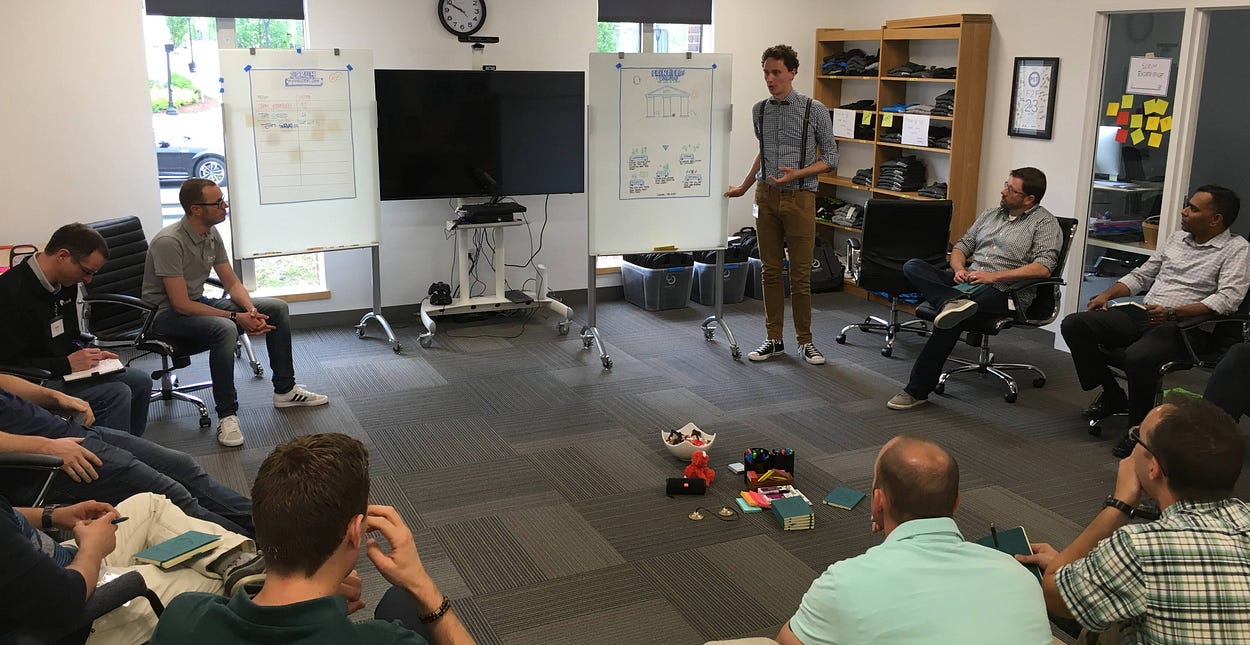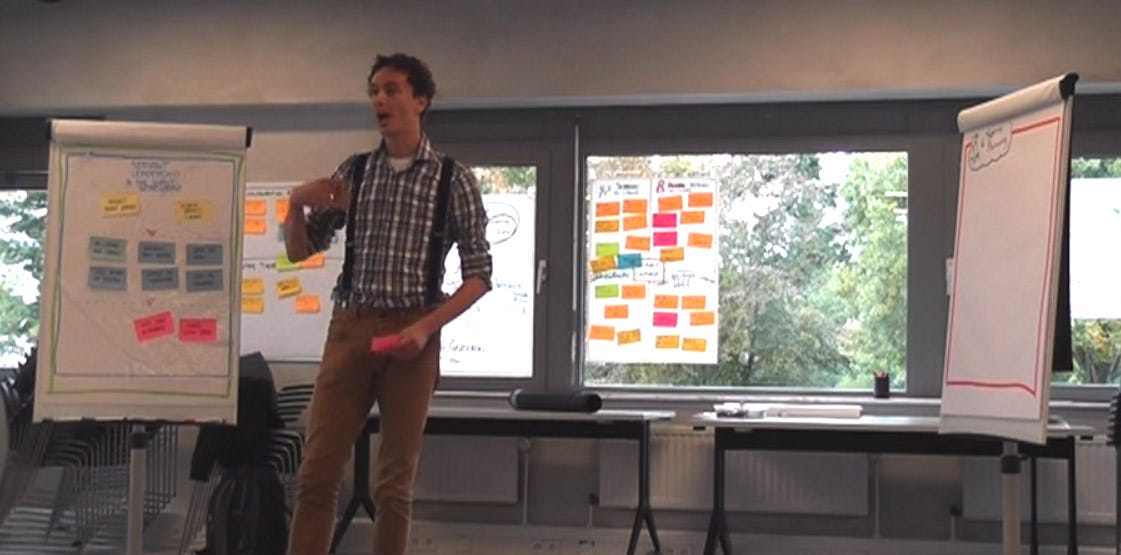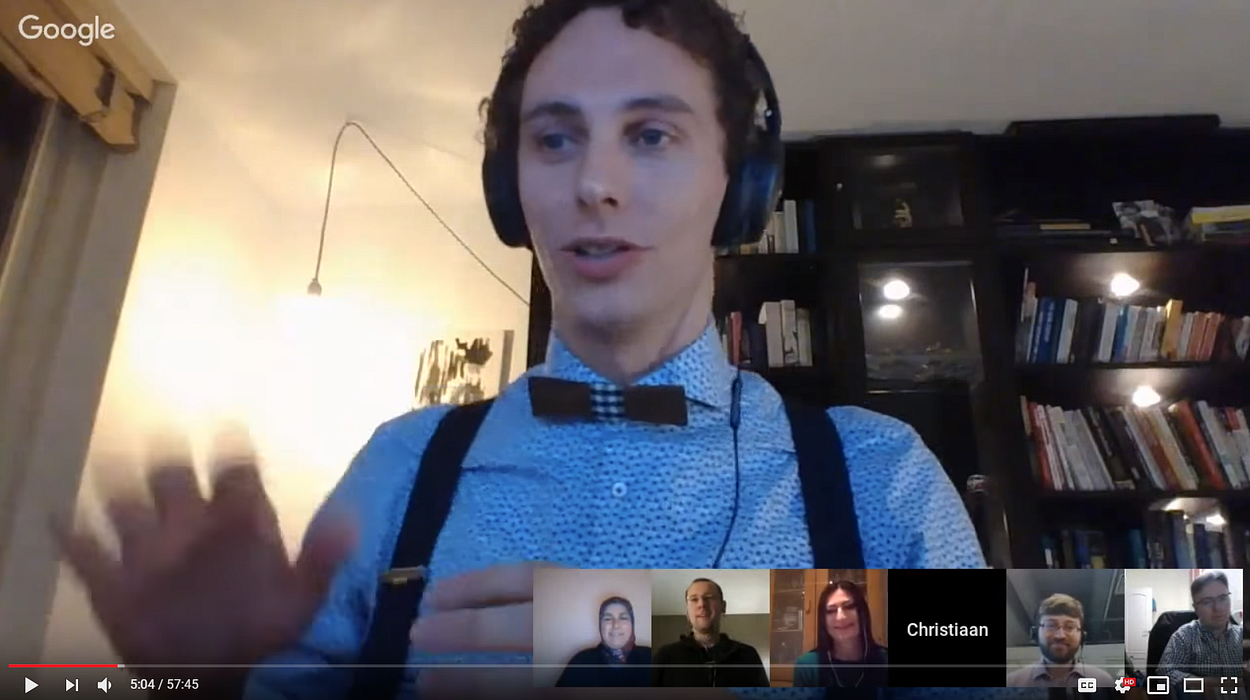Woohoo! Last week marked the official announcement from Scrum.org that I’m finally a Professional Scrum Trainer. I’m excited, amazed and incredibly humbled to join this community of professionals. In this post, I would like to share this journey. Perhaps it will inspire you towards a similar journey, or help you if you’re already on it.
My journey up to this point
Some years ago — in 2012 — I experienced my first Professional Scrum Master class. It was taught by Professional Scrum Trainer Gunther Verheyen, one of the few able to explain the Scrum Framework in a very concise and clear manner. Inspired by what I had learned, I translated this immediately to my role as a Scrum Master at NowOnline (more about this here). What inspired me, even more, was the conviction that was apparent in Gunther’s presentation. Here was a trainer who was obviously not in it for the money, but was sincerely trying to improve the profession of software development. It was easy for me to connect to this drive, and an example I hoped to follow one day.
Over the years that followed I got to know more and more Professional Scrum Trainers, including Laurens Bonnema, Dominik Maximini, Jasper Alblas, Sjoerd Kranendonk, Wim Heemskerk and — obviously — my co-liberator Barry Overeem. Although I had been teaching and training Scrum since 2012, it was never as a Professional Scrum Trainer. I’m sure this didn’t take away from the value and quality of my classes, but I did look up to these other PST’s.
When I started working more closely with Barry, I got the opportunity to co-teach the Professional Scrum Master-class with him. After having done so a significant number of times, we decided to start development on an advanced class for Scrum Masters (now the Professional Scrum Master II-class). Driving us here was our observation that many Scrum Masters had a rather ‘flat’ understanding of their role. For most, it was little more than the facilitation of the Scrum Events. We really wanted to go significantly deeper on what it meant to be a Servant Leader and how the Scrum Master is all about bringing the values and principles of Empiricism to life. After having taught this new class a number of times, Scrum.org acquired it and added it to their repertoire of classes.
By acquiring our class, Scrum.org welcomed me and Barry to their professional community as ‘Stewards’. This allowed us to take responsibility for gathering input and feedback from the community and improving the PSM-II class further. It was a great way to get to know many more PST’s from all over the world and an amazing experience altogether. It also felt like — and was constantly emphasized by PST’s who spurred me on (thanks Jill!)— that now would be a good time to become a Professional Scrum Trainer.
Why…?
What really cemented the decision for me was the 47th Face-to-Face that I partially attended in Boston while I was there with Barry to teach the PSM II-class. Scrum.org kindly invited me to join the PST’s for dinner. So I found myself in a room with over 50 people originating from over 40 different countries, having pleasant conversations about life, work and Scrum over dinner. I was also impressed throughout the days by the level of professionalism in the discussions (despite vehement disagreement), also evident in the mailing list, and the personal drive of those present. There is something awe-inspiring about bringing a diverse group of people together around a shared purpose they all connect to. I wanted to be part of that group.
So my journey began in earnest, spurred on by many PST’s and people from Scrum.org who had tried to get me to do this before.

Teaching then new Professional Scrum Master II-class at Scrum.org HQ to a group of PST’s, before the 47th Face-to-Face
The steps involved
Becoming a Professional Scrum Trainer isn’t an easy task. You need to …:
- Pass a preliminary interview with Scrum.org where you demonstrate that you have at least 4 years of demonstrable, intense experience as a Scrum Master;
- Pass the PSM-I, PSM-II, and PSM-III with a 95% score;
- Pass the Train-the-Trainer event;
- Pass a ‘peer review’ by a group of Professional Scrum Trainers;
The Professional Scrum Master III exam
In January of 2018 Scrum.org invited us to teach our new ‘Scrum Master Advanced’-class at Scrum.org HQ near Boston. The audience consisted of several Stewards and people important to Scrum.org. You can imagine that I was quite nervous about this, especially because I wasn’t a PST (yet). But I did feel that I needed to pass at least the PSM-III exam first. So that’s what I did, even though the PSM-III is something you normally do after the Train-the-Trainer and the preliminary interview with Scrum.org.
The PSM-III exam consists mostly of essay-based questions. Within a rather strict time-limit of 120 minutes, the pressure is high. The exam tests your knowledge of the underlying values and principles of Scrum with broad multi-level questions like this made-up question “What is made transparent by a Definition of Done? What can the Scrum Team do to impede this transparency?”. I loved it! More so than any other exam, it really made me think and consider the essence of Scrum. I noticed the following:
- You receive detailed feedback on your answers. This is not an exam that is graded by a computer, but by people with exhaustive experience with Scrum. I wasn’t really expecting this personal feedback, but it helped go much deeper. And it inspired some of the material that now lives in the Professional Scrum Master II-class;
- Compared to the PSM-I and the PSM-II, this exam really takes place on the ‘Ri’-level of the Shu-Ha-Ri stages of learning. This means that a lot of questions are gray, not obvious and involve a lot of ‘it depends on…’-answers;
- Many of the questions continued to pop up in my brain in the weeks that followed. It takes a while before you get your score back, so I mulled over whether or not I had answered the questions correctly. This actually helped me advance my thinking about many concepts central to Scrum;
The Train-the-Trainer
I participated in a Train-the-Trainer with Simon Reindl and Evelien Roos at Xebia in October 2018. I didn’t really know what to expect other than that it would be exhausting. The Train-the-Trainer is attached as the third day to a regular 2-day Scrum.org-class — in my case the Professional Scrum Master — and is attended only by trainer candidates. The purpose of the Train-the-Trainer is to assess your ability as a trainer. Can you engage with people in conversation? Can you explain the Scrum Framework clearly and concisely?

Screenshot of the recordings made as part of the Train-the-Trainer. Here, I am teaching about the Sprint Review.
I have to admit that I was really nervous about this event. Although I feel quite comfortable in front of a group, this group consisted of Simon, Evelien and a group of professional peers. In other words, the kind of feedback they would be capable of giving would be quite different than what you get from a regular class.
The Train-the-Trainer was indeed exhausting. Without giving too much away, you are invited several times to teach a randomly-picked topic or answer a randomly-picked ‘tough question’. There is little time to prepare, so you have to be able to respond on the spot. After each teaching opportunity, the others give you extensive feedback. I noticed the following:
- As a trainer, you really have to be able to take the stage. Don’t hide behind objects (desks, flip-overs, others), use your voice in a way that engages (e.g. vary pitch, vary volume) and make good use of posture, hand- and eye-movements to project energy and to draw people in. Being a good trainer requires vastly more than ‘knowing your Scrum’. You really need to be a performer, being able to use the space, your body and your voice to get the message across and manage the energy of the group;
- Don’t answer questions that you don’t understand. Clarify and validate your understanding of the question first, then answer it and finally verify if you answered it sufficiently;
- Keep your answers and teaching clear and concise. Add examples from your own experience to make it engaging and practical;
- Although the group may consider you an expert, it is perfectly fine to admit what you don’t know or can’t answer. In the world of complexity, expertise is overrated. So if you get a question that you can’t answer, admit it and follow-up on it after the class (or later) when you have an answer. I also noticed that very experienced PST’s can get details of the Scrum Framework wrong, but then openly admit and correct afterward. This is a marvelous example of this openness;
- The feedback I got focused on how I sometimes went a bit too deep into the question (by asking follow-up questions). It also turns out that its sometimes better to say ‘Thank you!’ to feedback than to dig deeper;
The Peer Review
For me, the Peer Review was the final step in the process of becoming a Professional Scrum Trainer. I didn’t really know what to expect, other than that it would involve a 1-hour interview by a group of PST’s. This included Rich Visotcky, Andre Gomes, Alex Ballarin, Seyhan Baki and Magdalena Firlit.
The purpose of the Peer Review is to assess your ability to answer tough questions. To do this, the PST’s play the role of students and, one at a time, ask you a tough question. These questions are often incomplete and vague, so it is your job to clarify and answer in an engaging (and correct) manner. The second round of my Peer Review involved an experimental format where the PST’s coined topics for discussion, more related to the ethical and practical side of being a trainer.
Again, I was quite nervous. Although the review took place at the end of a workday, I wasn’t able to get much work done throughout the day. I used the time to prepare and to calm my nerves a bit :)

A screenshot of the hangout for the Peer Review. As you can I see, I had a lot of fun. Despite being very nervous :)
What I noticed during the Peer Review:
- It's quite different answering questions while sitting in a chair. I took some time to prepare for this by creating my own virtual hangout and just answering questions (taken from the cards I mentioned earlier) like that;
- As with the Train-the-Trainer, it is important to ask for clarification if you don’t get the question and to verify afterward if you’ve managed to answer it sufficiently;
- A learning point for me is/was to avoid going into coaching mode too quickly. Sometimes you just need to answer the question and move on;
What helped me prepare
If you’re on the journey yourself or considering to do so, these things that helped me may be helpful to you as well:
- Obviously, any preparation begins by reading the Scrum Guide several times. I also read many books related to Scrum and complexity such as Scrum: A Pocket Guide to Scrum (by Gunther Verheyen), Thank You For Being Late by Thomas Friedman. And many more that are listed on the Scrum.org website;
- Together with Barry Overeem, I wrote several posts about the fundamentals of the Scrum Framework in our ongoing series of Scrum Mythbusters. This helped me find words to explain elements of Scrum, use metaphors and short-hands to explain tricky concepts;
- I created a deck of over 100 cards to test my ability to answer succinctly and clearly. Each card contained a question. Some questions involved essentials, like “How can a Scrum Master demonstrate Servant Leadership in the Sprint Review” whereas others tapped into metaphors (“Describe the role of the Product Owner with a metaphor”) or examples (“Give an example of a practice that can help when refining a Product Backlog”). In the days leading up to the PSM-III, the Train-the-Trainer and the Peer Review I randomly picked and answered a couple of cards every day;
- I spoke with many PST’s and asked them what question they had found the most challenging. I added these questions to the aforementioned stack of cards. This really helped me get a sense of what questions to expect;
- Being able to teach both the Professional Scrum Master- and Professional Scrum Master II-class with Barry Overeem was a great help. It gave me the opportunity to refine my wording, to add more stories and metaphors and to test potential response-patterns;
Yay!
So after quite some time of dragging of my feet, I finally got around to completing my journey towards Professional Scrum Trainer. Obviously, this is just the start of another one, and one where I hope to add value to this community. Thanks to everyone who kept pushing me!

